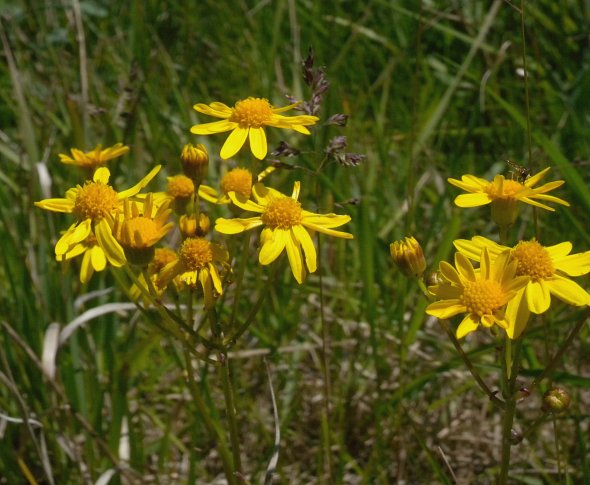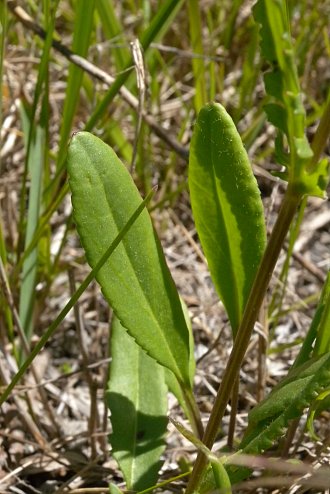
The central stalk terminates in a flat-headed panicle of 5-30 flowerheads. Each daisy-like flowerhead spans about ½-¾" across, consisting of 40 or more disk florets and 8-13 ray florets (rarely none); the disk and ray florets are both perfect and fertile. The corollas of the disk florets are deep golden yellow, cylindrical in shape, and 5-lobed. The petaloid extensions of the ray florets are yellow and linear-oblong in shape. Around the base of each flowerhead, there are several phyllaries (floral bracts) in a single series; they are about ¼" long. These phyllaries are linear in shape, glabrous, and mostly light green, except toward their tips, where they become pale purple. The branches and peduncles of the inflorescence are light green to pale purple and glabrous; there are often tiny bractlets where they diverge. These bractlets are scale-like and purple. The blooming period occurs from mid-spring to early summer, lasting about 3 weeks. Afterwards, the florets are replaced by small achenes with sessile tufts of white hair. These achenes are 1-2 mm. long and bullet-shaped. The root system consists of a short crown of fibrous roots and occasional rhizomes or stolons. Occasionally, clonal colonies of plants are produced from the rhizomes or stolons.
Cultivation: The preference is full or partial sun, moist conditions, and soil containing loam, sandy loam, or rocky material. Most growth and development occurs during the spring. The basal leaves persist throughout the warmer months into winter.

Range & Habitat: The native Balsam Ragwort is occasional in the northern half of Illinois, becoming rare or absent in the southern half of the state (see Distribution Map). Habitats include moist sand prairies, prairie remnants along railroads, sedge meadows, streambanks, moist sandy savannas, open woodlands, and abandoned fields. Areas with low ground vegetation and some history of disturbance are preferred.
Faunal Associations: The nectar and pollen of the flowerheads attract a variety of small to medium-sized insects, including cuckoo bees (Nomada spp.), Halictid bees, Andrenid bees, Syrphid flies, small butterflies and skippers, and miscellaneous beetles. An Andrenid bee, Andrena gardineri, is a specialist pollinator (oligolege) of Packera spp. (ragworts). Some insects feed on the foliage or seeds of ragworts. These species include caterpillars of the moth Agonopterix canadensis (Canadian Agonopterix) and the seed bug Neacoryphus bicrucis. The foliage of ragworts is toxic to most mammalian herbivores, causing liver damage.
Photographic Location: Along a bike path through a sand prairie at the Indiana Dunes National Lakeshore in NW Indiana.

Comments: As compared to the similar Prairie Ragwort (Packera plattensis), this ragwort prefers habitats that are more moist. Balsam Ragwort differs from the former species by its glabrous foliage and more narrow basal leaves. The basal leaves of other perennial ragworts (Packera spp.) in Illinois have basal leaves that are more broad. However, across its range, Balsam Ragwort is rather variable, possibly because of hybridization with similar species. The perennial ragworts in Illinois all bloom during the spring or early summer and they have showy yellow flowerheads. The annual and biennial ragworts in Illinois are mostly from Eurasia and they have less showy flowerheads. An exception is the native Butterweed (Packera glabella). This latter species is usually taller than the perennial ragworts and it lacks their conspicuous basal leaves during the blooming period. A scientific synonym of Balsam Ragwort is Senecio pauperculus; another common name of this species is Northern Ragwort.